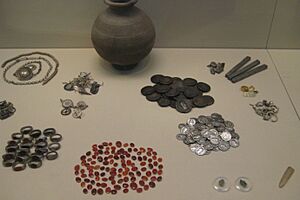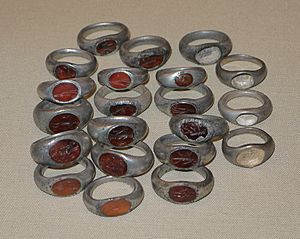Snettisham Jeweller's Hoard facts for kids
Quick facts for kids Snettisham Jeweller's Hoard |
|
|---|---|

Pot and some of the contents from the Snettisham Jeweller's Hoard
|
|
| Material | Gold Silver Gemstones Ceramic |
| Created | AD 155 |
| Discovered | 1985 Snettisham 52°52′33″N 0°29′49″E / 52.875842°N 0.49696038°E |
| Present location | British Museum |
The Snettisham Jeweller's Hoard is a special collection of ancient Roman-British jewelry and materials. It was found in 1985 in the village of Snettisham in Norfolk, England. Workers discovered it while building a house.
Experts believe the hoard was a jeweller's "working stock." This means it contained all the tools, raw materials, and unfinished items a jeweller would use. It was buried in a clay pot around the year 155 AD. The items show that the jeweller likely worked for wealthy customers.
What Was Found in the Hoard?
The hoard was hidden inside a clay pot about 17.5 centimeters (7 inches) tall. Some items, like bracelets, had to be bent to fit inside. The pot held many interesting things:
Coins
- There were 110 coins in total.
- Most were silver coins called denarii.
- Some bronze coins were also found.
- The newest coins were from 154-155 AD. This helps experts guess when the hoard was buried.
- The silver coins were probably used as raw material for making new jewelry. The bronze coins might have been the jeweller's everyday money.
Gemstones
- The hoard contained 117 engraved carnelian gemstones.
- Only seven of these stones were already set in rings.
- Most stones had simple carved designs, called intaglios.
- These carvings often showed symbols of good luck. They included gods and goddesses like Fortuna and Ceres.
- Different carving styles suggest that at least three different artists made the gemstones.
Jewelry Items
- The collection included many finished rings. Some had gemstones, while others were "snake-rings."
- Snake-rings were made from a silver ribbon. They had a snake's head stamped at each end.
- There were also snake-bracelets, made in a similar way using a hammer and special dies.
- Silver chain necklaces with crescent pendants were found. These might have represented the moon and the sun.
Tools and Other Finds
- A quartz burnishing tool was part of the hoard. This tool was used to polish metal. Traces of gold on it show it was used for gold jewelry.
- Two small pieces of ancient Roman linen cloth were also discovered. One was stuck to a coin, and the other to a ring.
- Many silver items had a dark coating called silver chloride corrosion. Items with copper had a green coating called verdigris. These are natural changes that happen over time.
The Snettisham Jeweller's Hoard is now kept and displayed at the British Museum in London.


